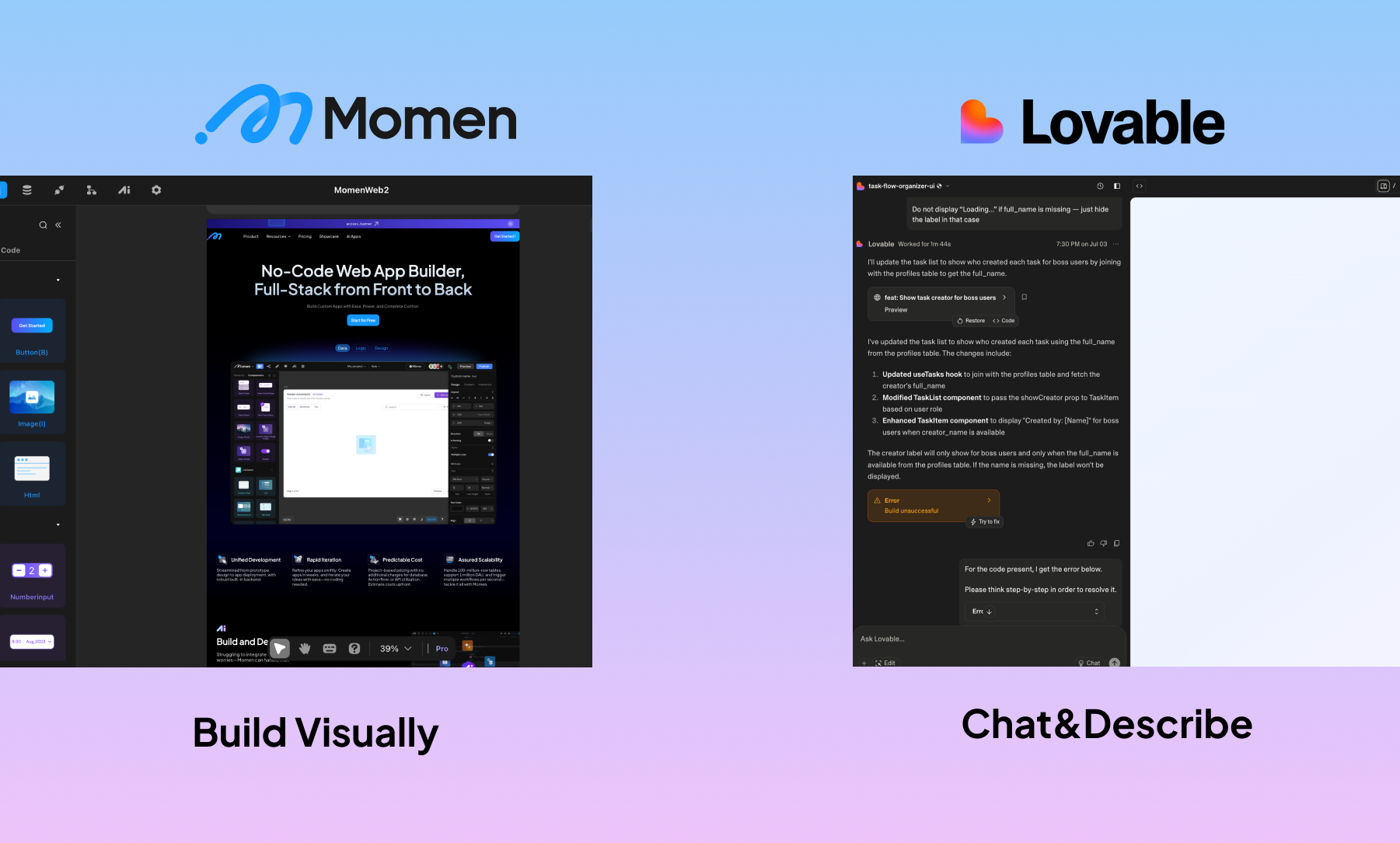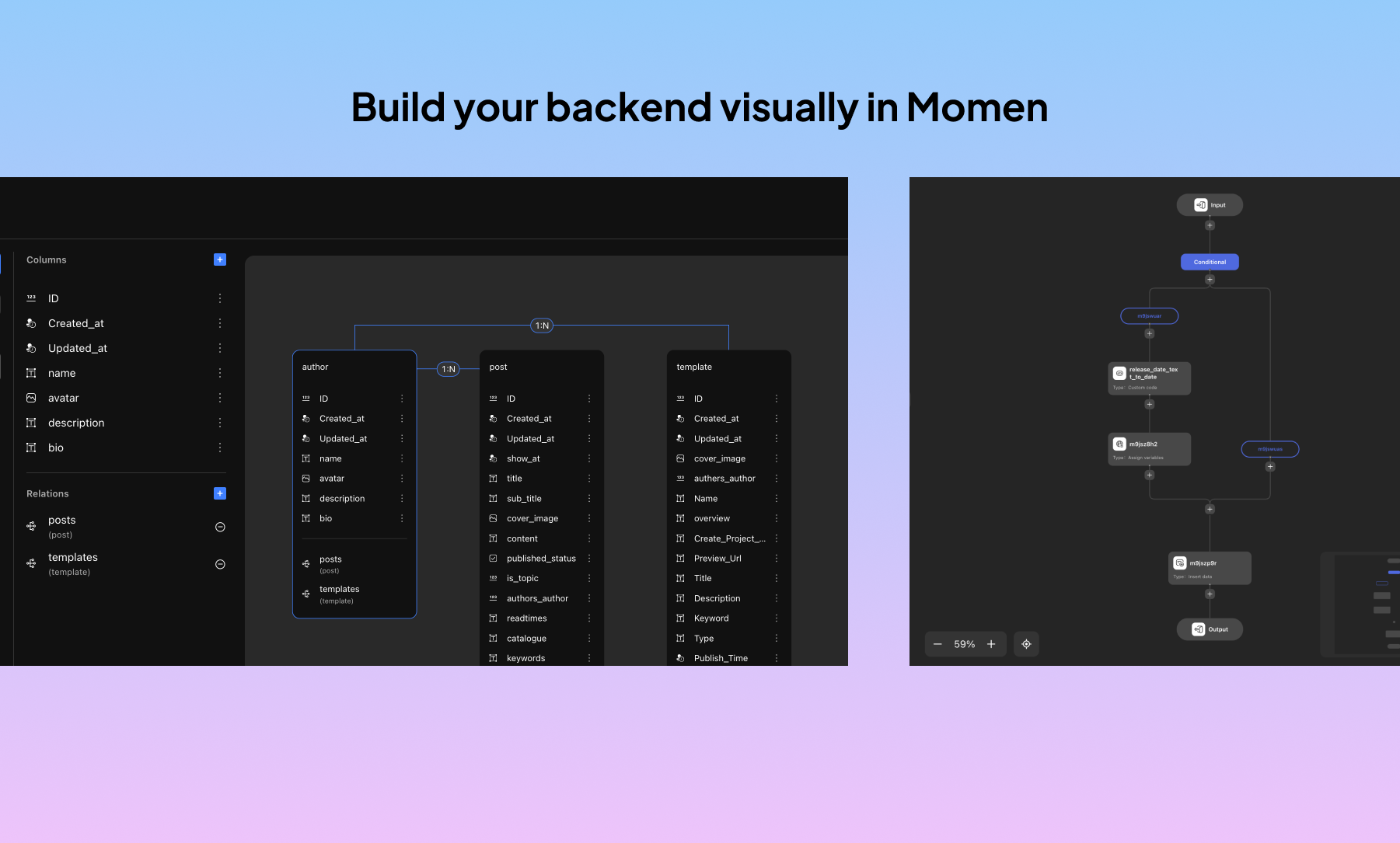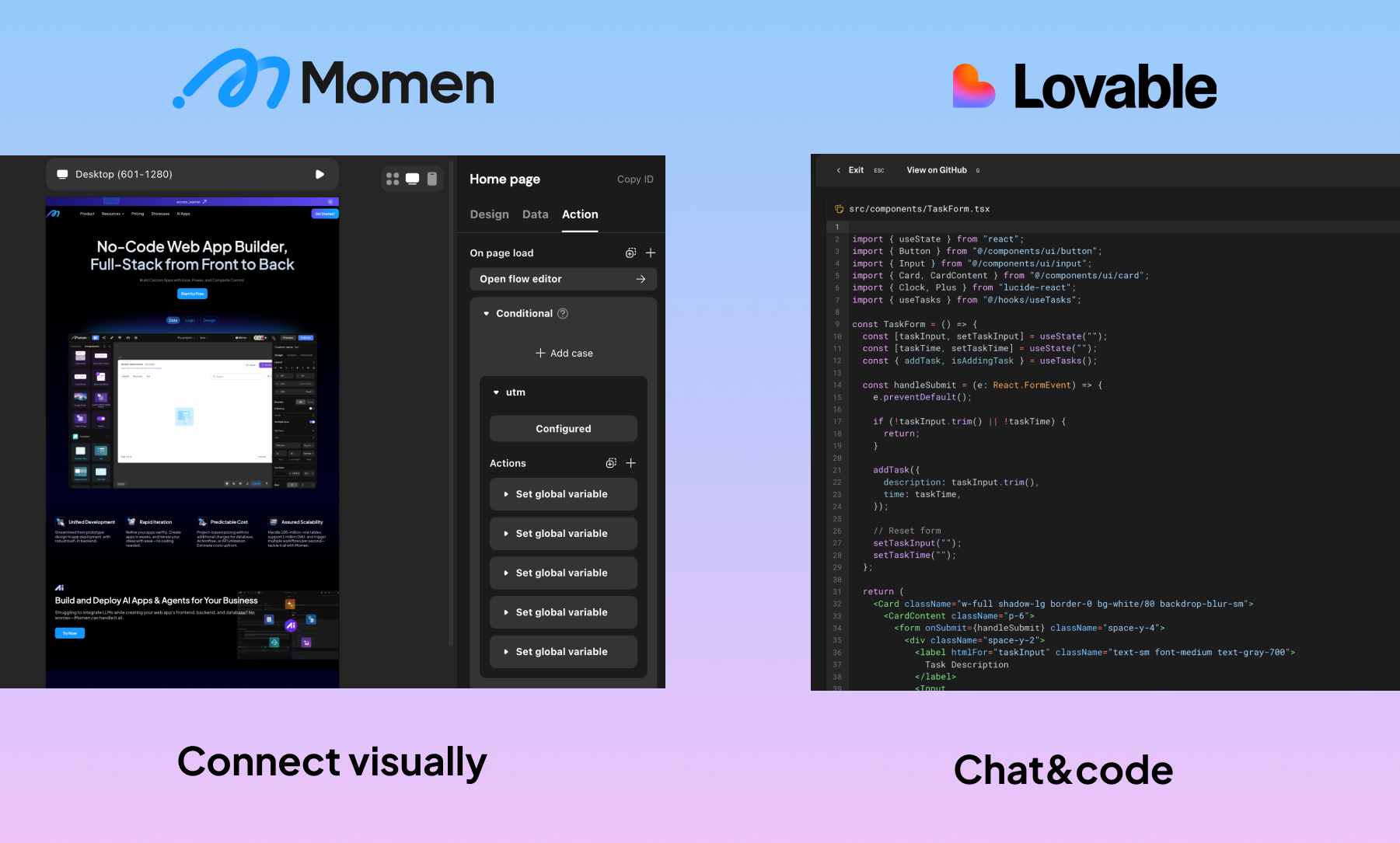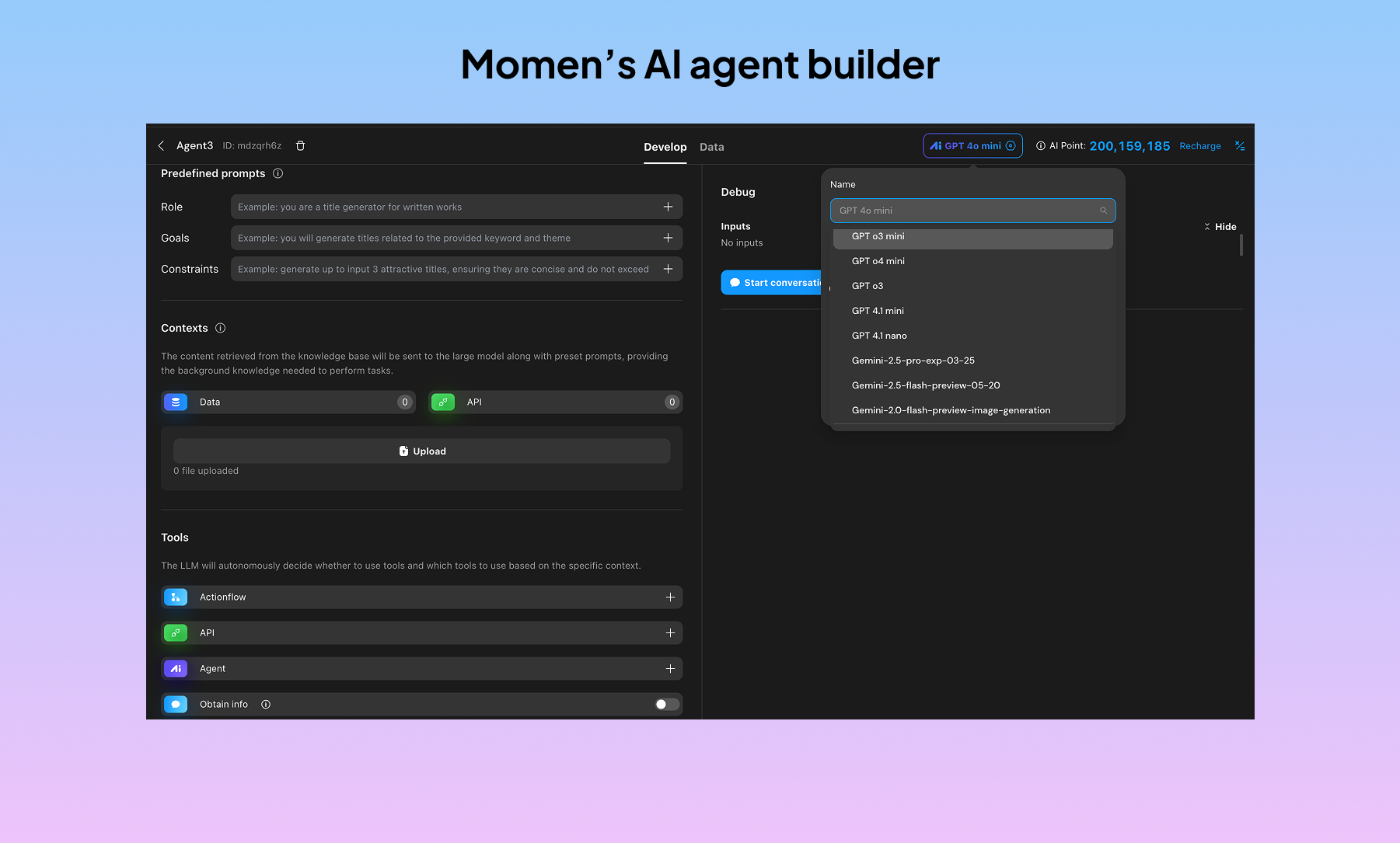Momen vs. Lovable: Building Agentic AI Apps With Control, Scale, and Speed
Introduction
The paradigm of software development is shifting fast: from traditional coding to no-code and now to vibe coding and AI-first tooling. Tools like Lovable have made it possible to build apps by simply describing what you want, while platforms like Momen offer a robust no-code full-stack environment to bring those ideas to production.
But here's the key insight: Vibe coding and no-code aren’t rivals. They’re two ends of the same spectrum. In this article, we’ll compare two fast-growing platforms — Lovable and Momen — and explore how combining them gives both speed and control for building real, scalable apps with AI power.
What Are Momen and Lovable?
Lovable is a fast-growing vibe coding tool that lets users build interfaces by prompting - "Describe it, and see it instantly." It's perfect for rapid UI prototyping and visualizing app ideas with minimal effort. But when things get more complex, especially on the backend or with AI, limitations start to show.
Momen is a no-code full-stack builder designed for more advanced use cases. It allows users to create UIs, backend workflows, databases, and AI agents all visually. The learning curve is steeper than Lovable's, but with it comes far more control.
Methodological Differences: Vibe Coding vs. No-Code
Before we compare features, it’s worth understanding the difference in philosophy:
Vibe Coding is code generation by natural language. But without deep context, this often results in orphan code — logic that's hard to maintain or scale.
No-Code, on the other hand, abstracts code into reusable, governed components. It doesn’t skip architecture or security. It makes software more maintainable from day one.
Rather than competing, these two approaches live on a spectrum. Each solves a different part of the development
Lovable vs. Momen: Head-to-Head Feature Breakdown
When building modern web applications, choosing the right tool depends on more than just how fast you can get a screen up. You also need to consider UI design flexibility, backend logic, AI integration, debugging capabilities, and long-term scalability. In this section, we compare Lovable and Momen across all these critical areas — to help you decide what works best for your project (or how they can work together).
UI Building Experience
Lovable’s standout strength lies in its prompt-based UI generation. You describe what you want in plain English — “a homepage with login and signup” — and within seconds, the layout appears. For non-technical users and early-stage founders, this vibe coding experience is incredibly satisfying and accessible. It's perfect for prototyping, pitching ideas, or simply getting visual feedback fast.
Momen, on the other hand, offers a visual canvas composed of atomic components. It’s not as instant as “prompt and see,” but it gives you complete control over layout, interactions, and behavior. Every UI element is editable and tightly integrated with backend data and logic. While it may take a few extra steps to design your interface, the reward is precision and reliability — no surprises when you connect it to logic later.
One important distinction: in Lovable, each UI iteration costs credits. This can make layout refinement a bit expensive or limiting. In Momen, you can tweak endlessly with no cost penalty.

Backend & Database
While Lovable excels in UI, backend functionality remains its weak spot. You can connect to databases like Supabase through chat prompts, which works well for simple use cases. But when it comes to complex data relationships, Row-Level Security (RLS), or multi-step workflows, things get tricky. Prompting your way through backend logic can lead to what many call “prompt purgatory” — where you’re stuck tweaking vague prompts and hoping for the right outcome. At that point, you might need to drop into SQL or code — which defeats the purpose for many no-code users.
Momen was built with backend logic in mind. It features a built-in visual database editor, where you can create tables, define relationships, and add access control — all without writing code. Backend workflows are handled through Actionflows, a visual builder for conditional logic, data processing, and automation. Whether it’s sending an email, updating a row, or calling an external API, everything is handled in a way that’s transparent and easy to debug.

Another key difference is how frontend and backend connect. In Momen, you define when a button triggers a database update or when a user action invokes an AI agent. You know exactly what happens and when. In Lovable, those connections can feel more like a black box — requiring you to inspect network requests or source code just to confirm if something is wired up properly.

AI Integration
We’re in the age of agentic AI — and having true AI functionality in your app is now essential. Lovable does let you connect to models like GPT or Gemini via prompts, but it’s mostly limited to basic LLM integration. You can create a chatbot or basic Q&A interface, but if you want Retrieval Augmented Generation (RAG), tool usage, or memory across sessions, you're back to writing edge functions or stitching things manually. Even worse, it’s hard to tell if the AI is working correctly without diving into the browser console. It’s easy to spend hours and credits debugging vague AI failures.
Momen includes a dedicated AI Agent Builder that’s fully visual, flexible, and production-ready. You choose your model (GPT, Gemini, etc.), define its role, goal, and inputs, and then enhance it by adding context (e.g., files, databases, APIs) and tools (e.g., calling another agent or triggering a backend workflow). The best part? You can see every interaction the agent has, including how it used tools, what inputs it received, and what output it generated. This makes debugging and iteration fast, accurate, and frustration-free.

Debugging & Maintenance
Prototyping is fun, but eventually every project hits bugs, logic gaps, or scalability issues. This is where the difference between vibe coding and structured no-code becomes most apparent.
In Lovable, debugging often means hunting through opaque errors or checking browser consoles. If your app depends on integrations, APIs, or complex logic, you'll need to jump between different tools, manually confirm each connection, and hope nothing breaks when you iterate. Prompt errors can be costly — both in credits and time. So before scaling in Lovable, ask:
Can I afford the trial-and-error debugging?
Do I have the prompt engineering skills to get this right?
Can my business afford the downtime if something silently fails?
Momen takes a different approach. Debugging is built-in. Every data flow, API call, and AI message is logged. If something breaks, you can trace exactly where and why. You don’t need to guess which part of your app failed — you’ll know. And when it’s time to fix it, everything is visual and scoped to the component in question.
It’s also worth noting: Momen doesn’t support exporting code — because you don’t need to. The infrastructure is designed to scale from MVP to millions of users. You’re not building a prototype; you’re building something maintainable from day one.
How They Can Work Together
Vibe coding and no-code aren't competing paradigms — they’re two ends of the same creative spectrum. Vibe coding tools like Lovable prioritize speed and inspiration, offering an intuitive way to bring interface ideas to life in seconds. No-code platforms like Momen emphasize precision, control, and scalability — making them ideal for long-term product development.
Smart builders don’t choose one or the other. They use both.
Lovable gives you rapid UI generation powered by natural language. Momen provides the logic, data infrastructure, and AI capabilities that take your prototype to a production-grade app. By combining the two, you get the best of both worlds: fast UI, reliable backend, and real agentic AI — all without writing a single line of code.
Take Momen’s Lovable Prompt Generator, for example. You can build and test a powerful AI agent in Momen, then use the tool to generate a Lovable-compatible prompt that connects your frontend to that backend agent instantly. It’s the missing link that turns a smart-looking UI into a real, functioning AI product.

Try Lovable Prompt Generator now!
Who Should Use What?
Each platform shines in different stages of a project:
Lovable is ideal for:
Rapid prototyping and UI mockups
Hackathons and demo days
Founders and designers testing early ideas
Momen is ideal for:
Apps that require backend logic and workflows
Building scalable, production-ready software
AI-first products with complex agent behavior
Use both together if:
You want the speed of vibe coding plus the structure of no-code
You’re building an AI app that needs both UI polish and backend depth
You’re a non-technical creator who wants to launch something real
Conclusion
Vibe coding and no-code represent different mindsets — exploration vs. execution. But in modern development, they’re most powerful when used together. Lovable gets your idea moving fast. Momen helps you take control, scale it, and make it real.
As the no-code ecosystem evolves, the future isn’t choosing between platforms — it’s knowing when and how to combine them.
